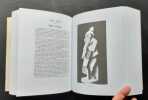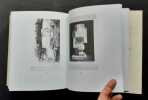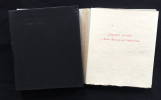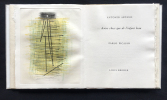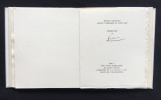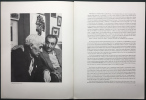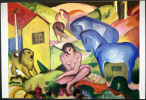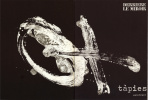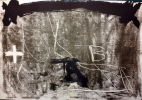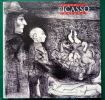-
Type
Any type (1)
Art print (3)
Artists book (1)
Book (2054)
Disk (1)
Magazine (135)
Maps (1)
Music sheets (1)
New book (6)
Photographs (3)
Posters (6)
Public sale (1)
-
Latest
Last 24h (3)
Last 3 days (1)
Last month (42)
Last week (4)
-
Language
Albanian (1)
Arabic (1)
Czech (2)
Dutch (2)
English (15)
French (2178)
German (6)
Italian (4)
Russian (1)
Spanish (3)
-
Century
17th (1)
18th (2)
19th (2)
20th (1260)
21st (142)
-
Countries
Belgium (85)
Brazil (3)
Canada (13)
Côte d'Ivoire (3)
Denmark (3)
France (1874)
Germany (1)
Greece (1)
Italy (8)
Switzerland (211)
United Kingdom (10)
United States of America (1)
-
Syndicate
ALAC (11)
CLAM (21)
CLAQ (2)
CNE (2)
ILAB (759)
NVVA (31)
SLACES (31)
SLAM (633)
Chronique de la peinture moderne.
Editions Corrêa. 1949. In-8° broché. Couverture illustrée. 218 pages. E.O. S.P.
Bon état.
Picasso Kunstlerbucher
, Hirmer Verlag GmbH, 2010 Hardcover, 300pp., 23x29cm., ills. in col. and b/w., very good copy. ISBN 9783777431017.
English summary: Picasso was one of the most prolific artists of the 20th Century, including in the decorative art of book design. Between 1905 and 1973, he designed more than 150 books, the most important of which are shown in a superb exhibition at the Museum Brandhorst in Munich. The focus of the exhibition lies on Picasso's experimentation with techniques and expressive possibilities in this fascinating medium. This catalog and the exhibition present the artist's book by Picasso as a complex object, not as a commercial art. The universal artist scratched, cut, stabbed or drew illustrations, but he also wrote poems, dedications and political texts. Page sequences, layout and typography inspired him as much as book covers and slipcases. He used almost every previously known printing technique and drove new technologies to their limits. The earliest illustrations were created at the request of his friend, the author Max Jacob. They were followed in the coming decades by projects with Paul Eluard, Tristan Tzara, Pierre Reverdy, and many others. Picasso also responded to the invitations of major publishers such as Pierre Andre Benoit, Iliazd and Georges Hugnet, and with them he created some of the most beautiful art books of the 20th Century. The catalog Pablo Picasso: Kunst am Buch traces the stimulus that books exerted on Picasso and his friends. Pictures of side tracks, covers and slipcases clearly highlight the diversity of the medium. In-depth articles explain the collaboration with various authors and publishers and provide insight into some of the most exciting artist books. German text. German description: Picasso war einer der produktivsten Kuenstler des 20. Jahrhunderts, auch auf dem Gebiet des Kuenstlerbuchs. Zwischen 1905 und 1973 gestaltete er mehr als 150 Buecher, von denen die bedeutendsten in einer auaergewohnlichen Ausstellung im Museum Brandhorst in Muenchen gezeigt werden. Im Mittelpunkt steht Picassos Experimentierfreude mit den Techniken und Ausdrucksmoglichkeiten dieses fesselnden Mediums. Katalog und Ausstellung prasentieren das Kuenstlerbuch Picassos erstmals als komplexes Objekt, nicht als Gebrauchsgraphik. Der Universalkuenstler ritzte, schnitt, stach oder zeichnete Illustrationen, er verfasste aber auch selbst Gedichte, Widmungen und politische Texte. Seitenabfolge, Layout, Typographie inspirierten ihn ebenso wie Bucheinbande und Schuber. Er benutzte fast jede bis dahin bekannte Drucktechnik und trieb neue Techniken an ihre Grenzen. Die ersten Illustrationen schuf Picasso auf Bitten seines Freundes, des Autors Max Jacob. Es folgten in kommenden Jahrzehnten Projekte mit Paul Eluard, Tristan Tzara, Pierre Reverdy und anderen. Picasso reagierte zudem auf die Einladungen bedeutender Verleger wie Pierre Andre Benoit, Iliazd und Georges Hugnet und schuf mit ihnen einige der schonsten Kuenstlerbuecher des 20. Jahrhunderts. Den entstandenen Buchkunstwerken merkt man die Freude ihrer Schopfer an jedem Detail an, sie kitzeln beim Durchblattern alle Sinne. Der Katalog "Pablo Picasso. Kunst am Buch" spuert dem Reiz nach, den Buecher auf Picasso und seine Freunde ausgeuebt haben. Aufnahmen von Seitenstrecken, Einbanden und Schubern machen die Vielfalt des Mediums anschaulich. Vertiefende Texte erlautern die Zusammenarbeit mit einzelnen Autoren und Verlegern und geben Einblick in einige der spannendsten Kuenstlerbuecher.
ARTAUD (Antonin). ARAGON (Louis). JACOB (Max). PERET (Benjamin). TZARA (Tristan). GRIS (Juan). BRAQUE (Georges). SURVAGE (Leopold). PICASSO (Pablo). DERAIN (André). DUFY (Raoul). COCTEAU (Jean). CENDRARS (Blaise). FELS (Florent). SAUVAGE (Marcel).
Reference : 45344
Action. "Cahiers de philosophie et d'art". Collection complète : Février 1920 - Mars-avril 1922 -
Paris : Jean-Michel Place, 1999 - Un fort volume (19,5x24,7cm) toilé imprimé sous jaquette illustrée en couleurs, de 1004 pages illustrées dans et hors texte. Présentations de Walter G. Langlois et Georges Gabory. En annexes : index des noms cités, des ouvrages cités et des revues et journaux. Réimpression en fac-similé des douze numéros parus de cette revue dirigée par Florent Fels et Marcel Sauvage. Exemplaire en bon état.
… AUTRE CHOSE QUE DE L'ENFANT BEAU. Une gravure originale en couleurs de Picasso (1957).
Louis Broder, Paris 1957. Collection "Miroir du poète" III. Un volume in-12 carré (165 x 135 mm), en feuilles, 36 pages, sous couverture de papier japon à rabats titrée en rouge sur le premier plat. Chemise et étui de l'éditeur noir et gris titré en rouge sur le dos. 1 GRAVURE ORIGINALE AU BURIN ET À LA POINTE SÈCHE EN COULEURS (150 x 120 mm). C'est la seule gravure en couleurs réalisée par Picasso pour un livre. La typographie est dûe à l'imprimerie Union et le tirage de la gravure à Georges Leblanc. Édition : 120 exemplaire sur papier ancien du Japon (100 + XX). Le n° X/XX SIGNÉ AU CRAYON PAR PICASSO au colophon. Parfait état. Référence : Cramer Picasso Les livres illustrés, n° 87, reproduit. ENGLISH : Pablo Picasso - Antonin Artaud "…Autre Chose que de l'Enfant beau". Collection Miroir du Poète III, Louis Broder, Paris, 1957 One etching printed in colours, 1957, on Japan paper. Title, text, justification and one etching, the justification signed in pencil by Picasso, copy number X/XX, in mint condition, loose in Japan upper wrappers with author's name and title printed in red on front, within grey paper-covered boards and black paper-covered slipcase with lettering in red on spine, the boards and slipcase in perfect condition (book). overall 178 x 152mm. "The only engraving in color Picasso ever made for a book". (Artist and The Book 239 ; Bloch 824 ; Cramer/Goeppert 8 7; Geiser C79 ; Monod 539). Reprenant un procédé utilisé l'année précédente pour l'illustration d'Autre chose de Pierre André Benoit, l'artiste a percé la matrice du noir, faisant apparaitre un cercle vide dans la gravure. Ce cercle, non pressé par la plaque, forme en relief une demi-sphère blanche, œil unique et vide d'un personnage aux membres désarticulés, très sûrement inspiré de l'un des grands dessins d'Artaud de 1946, "L'Homme et sa douleur", conservé au musée Cantini à Marseille.
Condition d'origine. Parfait état (Bloch 824 ; Cramer/Goeppert 8 7; Geiser C79).
… Autre chose que de l’enfant beau.
Paris, Louis Broder, 1957. In-12°, reliure janséniste de maroquin gris taupe; doublures et gardes de box jaune citron; couverture et dos conservés, étui. (Leroux, 1969). EDITION ORIGINALE. Illustrée d'une gravure originale à la pointe sèche et en couleurs de Pablo Picasso. Tirage à 120 exemplaires sur papier Japon, celui-ci l’un des 15 justifiés hors commerce, signé par Picasso.
Belle reliure janséniste d'époque.
Art d'Aujourd'hui. Série 2 numéro 3
Boulogne André Bloc 1951 In-4 agrafé, couverture illustrée
Série 2 Numéro 3. Janvier 1951. "Cinquante années de sculpture contemporaine". Revue mensuelle d'art contemporain. Textes de L. Degand, Del Marle, Gindertael C. Agay. Illustrations de Renoir, Bourdelle, Maillol, Picasso, Brancus, Pevsner, Lipchitz, Taueber, Rodin, Duchamp, Boccioni, Archipenko, Schoffer, Gris, Brauner, Prinner, Giacometti, Matisse... Tache en couverture illustrée Bon 0
[Braque, Picasso, Miro, Chagall] - Artistes Multiples. BRAQUE, Georges - Pierre Reverdy, François Chapon, Stanislas Fumet.
Reference : 365
(1963)
DERRIÈRE LE MIROIR n° 135-136 . PIERRE REVERDY, GEORGES BRAQUE. Déc.1962-Janv.1963.
Paris, Maeght éditeur, 1963. In-folio (380 x 280 mm) en feuilles, 36 pages. 1 LITHOGRAPHIE ORIGINALE EN COULEURS en couverture, 5 LITHOGRAPHIES EN COULEURS dont 1 en double page. 1 photographie de Georges Braque par Mariette Lachaud. Textes de Stanislas Fumet "Battements" et François Chapon "Le Mur et la mer". Extraits de "La Liberté des mers" de Pierre Reverdy. TIRAGE ORIGINAL.
Édition originale. Excellent état.
[Braque, Picasso, Miro, Chagall] - Artistes Multiples. BRAQUE, Georges - René CHAR, Henri MALDINEY.
Reference : 364
(1950)
Derrière le Miroir n° 25-26. BRAQUE. Janvier
Paris, Maeght éditeur, 1950. In-folio (380 x 280 mm) en feuilles, 12 pages. 1 LITHOGRAPHIE EN COULEURS et 5 dessins inédits en fac-similé. Texte de René Char "Sous la verrière" en forme de dialogue entre le peintre et le poète et un texte d'Henri Maldiney. Réimpression.
Très bel exemplaire de deuxième tirage en excellent état de conservation. Épuisé.
[Braque, Picasso, Miro, Chagall] - Artistes Multiples. BRAQUE, Georges - René CHAR, Henri MALDINEY.
Reference : 364_A
(1950)
Derrière le Miroir n° 25-26. BRAQUE. Janvier
Paris, Maeght éditeur, 1950. In-folio (380 x 280 mm) en feuilles, 12 pages. 1 LITHOGRAPHIE EN COULEURS et 5 dessins inédits en fac-similé. Texte de René Char "Sous la verrière" en forme de dialogue entre le peintre et le poète et un texte d'Henri Maldiney. Édition originale très rare.
Très bon exemplaire du rare premier tirage. Anciennement relié, traces de brochage au dos mais non rogné.
[Braque, Picasso, Miro, Chagall] - Artistes Multiples. BRAQUE, Georges - René CHAR, Henri MALDINEY.
Reference : 364-B
(1950)
Derrière le Miroir n° 25-26. BRAQUE. Janvier
Paris, Maeght éditeur, 1950. In-folio (380 x 280 mm) en feuilles, 12 pages. 1 LITHOGRAPHIE EN COULEURS et 5 dessins inédits en fac-similé. Texte de René Char "Sous la verrière" en forme de dialogue entre le peintre et le poète et un texte d'Henri Maldiney. Édition originale très rare.
PARFAIT EXEMPLAIRE DU PREMIER TIRAGE. État de neuf
[Braque] - Artistes Multiples. Georges BRAQUE - Stanislas Fumet.
Reference : 292
(1963)
Derrière le Miroir n° 138. GEORGES BRAQUE. Papiers collés 1912-1914. Mai 1963.
Paris, Maeght éditeur, 1963. In-folio (380 x 280 mm) en feuilles, 28 pages. 5 LITHOGRAPHIES EN COULEURS d'après les papiers collés de la période cubiste, dont 2 en double page. 24 reproductions en noir et blanc. Texte de Stanislas Fumet "Ne nous évadons pas, ma peinture". Exposition de 29 papiers collés et fusains de 1911 à 1914.
Tirage original. Bel exemplaire.
[Kandinsky] - Artistes Multiples. KANDINSKY, Wassily - Pierre Volboudt, Will Grohmann.
Reference : 348
(1962)
Derrière le Miroir n° 133-134. DER BLAUE REITER. Oct.-Novembre 1962.
Paris, Maeght éditeur, 1962. In-folio (380 x 280 mm) en feuilles, 38 pages. 2 LITHOGRAPHIES EN COULEURS à double-page d'après W. Kandinsky et F. Marc. 1 lithographie en couleurs d'après Douanier-Rousseau. 22 reproductions d'œuvres de Kandinsky, Schönberg, Klee, Braque, Matisse, Macke, Marc, Bloch, Münter, Picasso, etc… Textes de Pierre Volboudt, Will Grohmann et H.H. Stuckenschmidt. DLM édité en 1962 pour l'exposition hommage à la revue "Der Blaue Reiter" à la Galerie Maeght : 42 tableaux de 21 peintres, et partitions de Schönberg et de Webern ! TIRAGE ORIGINAL complet du bulletin "Chroniques"
Édition originale. Très bon état, infimes froissements au dos. Très important numéro de la revue.
[Tapies] - Artistes Multiples. TÀPIES, Antoni - Georges Raillard.
Reference : 370
(1974)
Derrière le Miroir n° 210 . TÀPIES. Monotypes . Juin 1974
Paris, Maeght éditeur, 1974. In-folio (380 x 280 mm) en feuilles, 24 pages. 4 LITHOGRAPHIES ORIGINALES EN NOIR. 3 lithographies d'interprétation en double-page tirées en brun. Tapuscrit de Georges Raillard "Tapiès à mots découverts" reproduit en négatif. Exposition de de 36 monotypes de TAPIES de 1974.Tirage original.
Très bel exemplaire. État de neuf. Édition originale.
PICASSO portrait, figurine, skulptur.
Bonn, VG Bild Kunst - Impressum, 1989; in-4, 167 pp., br. Broché en bon état (en allemand).
Broché en bon état (en allemand).
Art Press - Directeur : J.P. de Kerraoul - Rédactrice en chef : Catherine Millet
Reference : 99606
(1982)
Art Press N°61 : LES EXPOS DE L'ETE : "Dibbets" à Sénanque (G. Duby) - "Erro" à Nîmes (M. Le Bot) - "Les Nouveaux Réalistes" à Nice (D. Abadie) - "La Fondation Maeght" à Saint-Paul (A. Malraux) - "Picasso" à Céret (L. Curzi) - "Peintres espagnols" à Jau et à Toulouse (A. Urrutia) - "Mythe et Tragédie" à Saint-Etienne (C. Francblin) - "Fragments/Figures" à Bordeaux (Claire Stoullig) - "La photo" à Arles (M. Nuridsany) - "Le Théâtre" à Avignon par G. Banu // ANDRE CHASTEL, interview (texte par Marcelin Pleynet) - ROBERT PINGET, interview et inédit
1982 N° 61 - Juillet-Août 1982 - Mensuel illustré paraissant le 5 de chaque mois - Imprimerie Le Scorpion - In-4 broché - 54 p.
Bon état.
Hommage à Pablo Picasso - Peintures Grand Palais - Dessins sculptures céramiques, Petit Palais.
Paris, Ministère d'état - affaires culturelles - ville de Paris, 1967; in-4, 508 pp., br. Broché un peu écorné, ptes usures vendu dans l'état (couleurs passées).
Broché un peu écorné, ptes usures vendu dans l'état (couleurs passées).
Hommage à Pablo Picasso - Peintures Grand Palais - Dessins sculptures céramiques, Petit Palais.
Paris, Ministère d'état - affaires culturelles - ville de Paris, 1967; in-4, 508 pp., br. 3e édition.
3e édition.
Pablo Picasso Gravures.
Association du Château de Vauvenargues-Succession Picasso 2011 In-8° au format carré (22x22cm), 91pages, 82 gravures en noir à pleine pages, ensemble à l'état de neuf.
Comme neuf Franco de port France jusqu'à 30 euros. MONDIAL RELAY privilégié et pays suivants desservis : Portugal, Pologne, Espagne, Allemagne, Autriche, Pays Bas, Luxembourg, Italie, Belgique. Toutes les étapes de votre achat sont accompagnées. Achat, estimations et listages France / Suisse (sur rdv).
L'homme de l'art D. H. Kahnweiler 1884-1979
Fort in-8, reliure pleine toile éditeur sous jaquette illustrée en couleur, 540 pp. Editions Balland, sélectionné par Le Grand Livre du Mois, Paris, 1988. Avant-propos - I. L'aventure, 1884-1914 : 1. L'itinéraire de Mannheim à Stuttgart, 1884-1902. - 2. Paris-Londres et retour, 1902-1906. - 3. Galerie Kahnweiler, 1907. - 4. Les années héroïques, 1908-1914. - Entracte : L'exil, 1915-1920 - II. La traversée du ...
Avec un cahier d'illustrations en noir et blanc en hors-texte. --- Plus d'informations sur le site archivesdunord.com
Phone number : 01 42 73 13 41
Malraux et Picasso - Une relation manquée
Infolio, collection Archigraphy Poche, Gollion, 2013. In-12, broché sous couverture illustrée, 117 pp. Introduction - 1. A l'école des avant-gardes - 2. L'Espagne, Guernica, la Libération - 3."Croyez-vous que je sois ministre?" - 4. Il y eut un petit bonhomme des Cyclades - Conclusion : "La peinture de la peinture" - Sélection bibliographique. ...
--- Plus d'informations sur le site archivesdunord.com
Phone number : 01 42 73 13 41
[# ILLUSTRATEUR: Picasso Pablo (frontispice)] - # AUTEUR: Huidobro Vicente
Reference : 2268
(1932)
# TITRE: Gilles de Raiz - Pièce en Quatre actes et un épilogue
# AUTEUR: Huidobro Vicente # ILLUSTRATEUR: Picasso Pablo (frontispice) # ÉDITEUR: Editions Totem - librairie José Corti - Paris # ANNÉE ÉDITION: 1932 # COUVERTURE: Souple - imprimée - titre rouge # DÉTAILS: Grand in 8° broché 232pp. + 2ff. Avec un portrait de l'auteur par Pablo Picasso et deux dessins de Joseph Sima. Pièce de théâtre sur l'homme auquel plus de 200 ouvrages ont été consacrés; lecture iconoclaste et flamboyante d'une légende éternelle dans laquelle l'auteur convoque Barbe bleue, mais aussi le marquis de Sade, Don Juan, Huysmans, Bernard Shaw et Huidobro lui-même. ”Monstre sacré” auquel Georges Bataille consacra 67 pages terriblement personnelles en guise de prologue à la publication du procès de Gilles de Rais. # PHOTOS visibles sur www.latourinfernal.com
# ÉTAT: Très bon état, page de l'achevé d'imprimer à l'envers.
# TITRE: Pablo Picasso
# AUTEUR: Reverdy Pierre # ILLUSTRATEUR: Picasso # ÉDITEUR: Gallimard -éditions de la nouvelle revue française - Paris # COLLECTION: Les peintres français nouveaux n° 16 # ANNÉE ÉDITION: 1924 # COUVERTURE: Souple - imprimée illustrée en couleurs - titre noir et rouge # DÉTAILS: In 12° broché 63pp. 26 reproductions de peintures et dessins précédées d'une étude critique, de notes biographiques et documentaires et d'un portrait inédit de l'artiste dessiné par lui-même et gravé sur bois par G. Aubert. # PHOTOS visibles sur www.latourinfernal.com
# ÉTAT: Bon état
Aujourd'hui : Art et architecture n° 4, 1955
Paris, auto-édité, 1955. Grand in-folio de 310 x 240 mm, 108 pp. Édition originale. Couverture colorée de rouge, illustré en noir et blanc et couleurs (bleu surtout). Avec des passages sur la mort de Fernand Léger, des contributions de et sur Pablo Picasso, 6 pages consacrées à l'église Notre-Dame-du-Haut à Ronchamp réalisée par Le Corbusier, quatre pages sur des constructions d'Arne Jacobsen, six pages sur le CNIT à Paris (Arch. Camelot, De Mailly, Zehrfuss, Prouvé ingénieur conseil), quatre pages sur du mobilier et luminaire (Alain Richard, Caillette, Rinaldi, Jacques Biny), huit pages sur l'Exposition de l'habitation H55 à Halsingborg et ainsi de suite.
Quelques plis et traces de frottement sur les plats, pli au coin extérieur du bas, sinon très bon état.
Calatogo - Las Meninas - Barcelona, Mayo de 1968 -
Ayuntamiento de Barcelona. 1968. In-4. En feuillets. Bon état, Couv. convenable, Dos satisfaisant, Intérieur frais. En feuillets de 8 pages sous pochette illustrée en couleurs.. Texte en langue expagnole.. . . . Classification Dewey : 56-Catalogue
Classification Dewey : 56-Catalogue
Las Meninas - Barcelona, Mayo de 1968 -
Ayuntamiento de Barcelona. 1968. In-4. Broché. Bon état, Couv. convenable, Dos satisfaisant, Intérieur frais. En feuillets de 4 pages sous couverture dépliante illustrée en couleurs.. . . . Classification Dewey : 708-Galeries, musées, collections d'art
Classification Dewey : 708-Galeries, musées, collections d'art
 Write to the booksellers
Write to the booksellers
